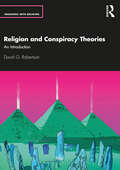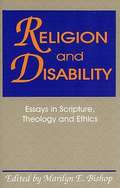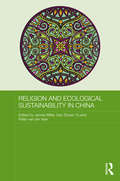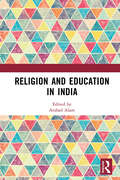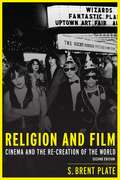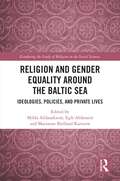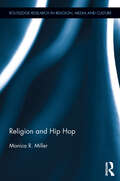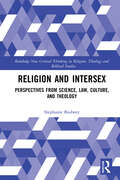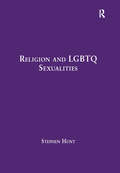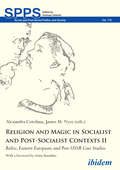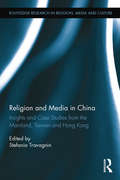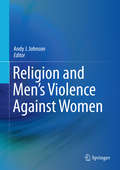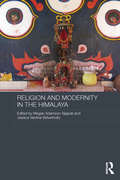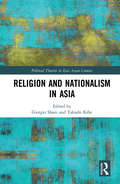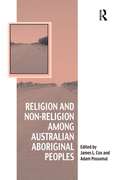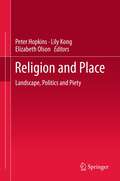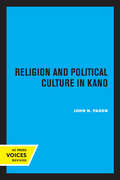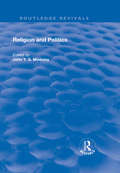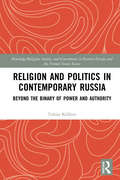- Table View
- List View
Religion and Conspiracy Theories: An Introduction (Engaging with Religion)
by David G. RobertsonReligion and Conspiracy Theories: An Introduction is the first accessible volume to systematically examine the relationship between religion and conspiracy theories in the contemporary world in critical and historical perspective.It lays out the historical development of these important categories, considers different theoretical approaches and looks at case studies of conspiracy theories in religion, about religion and as religion. It maintains a critical perspective throughout on the relationship between truth and power, and in the process provides a fresh perspective on belief and worldviews in our modern world.Designed for use in the classroom, the book features helpful diagrams and resources for teachers. It is an essential read for all students of religion and conspiracy theories, as well as scholars of politics, religious studies, sociology, anthropology and cultural studies.
Religion and Disability: Perspectives in Scripture, Theology, and Ethics
by Marilyn E. BishopA collection of essays on disability and religion.
Religion and Ecological Sustainability in China (Routledge Contemporary China Series)
by James Miller Peter van der Veer Dan Smyer YuThis book sheds light on the social imagination of nature and environment in contemporary China. It demonstrates how the urgent debate on how to create an ecologically sustainable future for the world’s most populous country is shaped by its complex engagement with religious traditions, competing visions of modernity and globalization, and by engagement with minority nationalities who live in areas of outstanding natural beauty on China’s physical and social margins. The book develops a comprehensive understanding of contemporary China that goes beyond the tradition/ modernity dichotomy, and illuminates the diversity of narratives and worldviews that inform contemporary Chinese understandings of and engagements with nature and environment.
Religion and Education in India
by Arshad AlamThis book studies the relationship between religion and education in the Indian context. It analyses the creative interface between religion and education as empirical categories and overlapping modes of pedagogical transmission. The volume investigates the ways in which religious identities are shaped through education both at home and at school. It brings together academics and researchers working in different faith traditions like Islam, Hinduism, and Sikhism to understand the significance of transmitting religious education and the need to pay closer attention to sites through which religious instruction is being disseminated. Topical and lucid, this book will be an important reading for scholars and researchers of sociology, religious studies, secularism, sociology of education, political sociology, South Asia studies, and education in general.
Religion and Film: Cinema and the Re-creation of the World (Critical Concepts In Media And Cultural Studies)
by S. Brent PlateReligion and cinema share a capacity for world making, ritualizing, mythologizing, and creating sacred time and space. Through cinematography, mise-en-scène, editing, and other production activities, film takes the world “out there” and refashions it. Religion achieves similar ends by setting apart particular objects and periods of time, telling stories, and gathering people together for communal actions and concentrated focus. The result of both cinema and religious practice is a re-created world: a world of fantasy, a world of ideology, a world we long to live in, or a world we wish to avoid at all costs.Religion and Film introduces readers to both religious studies and film studies by focusing on the formal similarities between cinema and religious practices and on the ways they each re-create the world. Explorations of film show how the cinematic experience relies on similar aesthetic devices on which religious rituals have long relied: sight, sound, the taste of food, the body, and communal experience. Meanwhile, a deeper understanding of the aesthetic nature of religious rituals can alter our understanding of film production. Utilizing terminology and theoretical insights from the study of religion as well as the study of film, Religion and Film shows that by paying attention to the ways films are constructed, we can shed new light on the ways religious myths and rituals are constructed and vice versa.This thoroughly revised and expanded new edition is designed to appeal to the needs of courses in religion as well as film departments. In addition to two new chapters, this edition has been restructured into three distinct sections that offer students and instructors theories and methods for thinking about cinema in ways that more fully connect film studies with religious studies.
Religion and Gender Equality around the Baltic Sea: Ideologies, Policies, and Private Lives (Gendering the Study of Religion in the Social Sciences)
by Marianne Bjelland Kartzow Milda Ališauskienė Eglė AleknaitėThis volume aims to rethink the intersections of gender and religion, as well as the secular and religious, in implementing and challenging gender equality at individual, institutional, and societal levels in the regions around the Baltic Sea. Acknowledging the diversity of societies and the significance of socio-historical contexts, the empirical data discussed in this book draw attention to the under-researched region of post-socialist Baltic states. The analyses presented in the chapters are based on fieldwork carried out in Lithuania, Latvia, Estonia, and Norway. This volume includes sociological, anthropological, historical, political science, and theological perspectives and covers five broad research areas: a shifting concept of gender equality and its developments in Baltic and Nordic countries; a diversity of developments within religious groups related to issues of gender equality and the negotiation of competing gender ideologies; inter-religious developments and gender equality; the role of religions in the construction of public discourse on gender equality; and religious socialization, focusing on the promotion of religious gender models through socialization and public education.
Religion and Gender-Based Violence: Global and Local Responses to Harmful Practices (Routledge Research in Religion and Development)
by Tamsin Bradley Chia Longman Brenda BartelinkThis book takes religion as an entry point for a deeper exploration into why practices of gender-based violence continue and what possible actions might help to contribute to their eradication. International donors are committed to reducing and ending gender-related harm, particularly violence against women, but clear answers as to why harmful practices persist are often slow to emerge. Theological research struggles to find strong links, yet religion is often referred to by local people as the reason for practices such as female cutting, male circumcision, early and forced marriage, nutritional taboos and birth practices, mandatory (un)veiling, harmful spiritual practices, polygamy, gender unequal marital and inheritance rights and so-called honour crimes. This book presents empirical cases of religious, non-religious and secular actors, including local and international governmental and non-governmental agencies in the fields of development, health and equality policies. Tracing their different understandings of how religion is entangled with gender-based violence both contextually as well as historically, the book sheds light on helpful and unhelpful as well as erroneous and harmful understandings of such practices in local and global perspectives. Centralising the perspectives of women themselves, this book will be an important read for development practitioners and policy makers, as well as for researchers across religious studies, gender studies, and global development.
Religion and Hip Hop: Mapping The New Terrain (Routledge Research in Religion, Media and Culture #3)
by Monica R. MillerReligion and Hip Hop brings together the category of religion, Hip Hop cultural modalities and the demographic of youth. Bringing postmodern theory and critical approaches in the study of religion to bear on Hip Hop cultural practices, this book examines how scholars in religious and theological studies have deployed and approached religion when analyzing Hip Hop data. Using existing empirical studies on youth and religion to the cultural criticism of the Humanities, Religion and Hip Hop argues that common among existing scholarship is a thin interrogation of the category of religion. As such, Miller calls for a redescription of religion in popular cultural analysis - a challenge she further explores and advances through various materialist engagements. Going beyond the traditional and more common approach of analyzing rap lyrics, from film, dance, to virtual reality, Religion and Hip Hop takes a fresh approach to exploring the paranoid posture of the religious in popular cultural forms, by going beyond what "is" religious about Hip Hop culture. Rather, Miller explores what rhetorical uses of religion in Hip Hop culture accomplish for various and often competing social and cultural interests.
Religion and Inequality in America
by Lisa A. Keister Darren E. SherkatDespite the growing quantity and quality of research connecting religion to inequality, no single volume to date brings together key figures to discuss various components of this process. This volume aims to fill this gap with contributions from top scholars in the fields of religion and sociology. The essays in this volume provide important new details about how and why religion and inequality are related by focusing on new indicators of inequality and well-being, combining and studying mediating factors in new and informative ways, focusing on critical and often understudied groups, and exploring the changing relationship between religion and inequality over time.
Religion and Intersex: Perspectives from Science, Law, Culture, and Theology (Routledge New Critical Thinking in Religion, Theology and Biblical Studies)
by Stephanie A. BudweyThis book considers the situation of intersex people who have faced erasure in the areas of science, law, culture, and theology due to the assumption that all humans are either ‘female’ or ‘male.’ Centered in interviews conducted with German intersex Christians, this book argues that moving from a paradigm of sexual dimorphism to sexual polymorphism will help promote the full humanity and flourishing of intersex people by creating a world where intersex individuals are no longer coerced and/or forced to undergo non-consensual, medically unnecessary treatment, no longer experience human rights violations because of their lack of legal protection, no longer feel inhuman and Other due to epistemic injustice that stems from socio-cultural norms and stereotypes, are no longer told they are not made in God’s image as a result of a sexually dimorphic understanding of Genesis 1:27, and no longer feel excluded and invisible in worship services that do not recognize them. This combination of the practical and the spiritual allows for a reconsideration of the medical treatment and pastoral care that should be available to intersex people. This book will be helpful to those in the disciplines of science, law, culture, and theology, particularly those in gender and theological studies and those already in and studying for lay and ordained ministry.
Religion and LGBTQ Sexualities: Critical Essays
by Stephen HuntThis compiled and edited collection engages with a theme which is increasingly attracting scholarly attention, namely, religion and LGBTQ sexuality. Each section of the volume provides perspectives to understanding academic discourse and wide-ranging debates around LGBTQ sexualities and religion and spirituality. The collection also draws attention to aspects of religiosity that shape the lived experiences of LGBTQ people and shows how sexual orientation forges dimensions of faith and spirituality. Taken together the essays represent an exploration of contestations around sexual diversity in the major religions; the search of sexual minorities for spiritual ’safe spaces’ in both established and new forms of religiosity; and spiritual paths formed in reconciling and expressing faith and sexual orientation. This collection, which features contributions from a number of disciplines including sociology, anthropology, psychology, history, religious studies and theology, provides an indispensable teaching resource for educators and students in an era when LGBTQ topics are increasingly finding their way onto numerous undergraduate, post-graduate and profession orientated programmes.
Religion and Language in Post-Soviet Russia (Routledge Contemporary Russia and Eastern Europe Series)
by Brian P. BennettChurch Slavonic, one of the world's historic sacred languages, has experienced a revival in post-Soviet Russia. Blending religious studies and sociolinguistics, this is the first book devoted to Church Slavonic in the contemporary period. It is not a narrow study in linguistics, but uses Slavonic as a passkey into various wider topics, including the renewal and factionalism of the Orthodox Church; the transformation of the Russian language; and the debates about protecting the nation from Western cults and culture. It considers both official and popular forms of Orthodox Christianity, as well as Russia's esoteric and neo-pagan traditions. Ranging over such diverse areas as liturgy, pedagogy, typography, mythology, and conspiracy theory, the book illuminates the complex interrelationship between language and faith in post-communist society, and shows how Slavonic has performed important symbolic work during a momentous chapter in Russian history. It is of great interest to scholars of sociolinguistics and of religion, as well as to Russian studies specialists.
Religion and Magic in Socialist and Post-Socialist Contexts II: Baltic, Eastern European, and Post-USSR Case Studies (Soviet and Post-Soviet Politics and Society #173)
by James M. Nyce Alexandra CotofanaReligion and magic have often played important roles in Baltic, Eastern European, and post-Soviet societies like those in Russia, Romania, Serbia, Latvia, Kyrgyzstan, and Estonia. Taken together, the studies presented in this collection suggest that the idea that religion and magic are connected to each other in some consistent, universal way may be nothing more than a remnant from nineteenth-century anthropology. Further, these studies challenge another part of anthropology's historical legacy: the idea that magic is something that modernity and modernization will transcend. Rather, these studies suggest instead that magic is a form of work that brings modernity into being and helps render it intelligible to those who find themselves engaged in its creation.This volume brings together historical (pre- and post-1989), ethnographic, and area studies that look at the divergent roles of state, culture, society, tradition, and the individual in enactments of magic and religion. Assessing the role magic and religion have played in the countries of Eastern Europe and beyond before and after the Cold War, it is an absorbing read for scholars of anthropology and history as well as ethnology.
Religion and Magic in Socialist and Post-Socialist Contexts: Historic and Ethnographic Case Studies of Orthodoxy, Heterodoxy, and Alternative Spirituality (Soviet and Post-Soviet Politics and Society #163)
by James M. Nyce Alexandra CotofanaReligion and magic have played important roles within Eastern European societies where social reality and sociopolitical balance may differ greatly from those in the West. Although often thought of as being two distinct, even antagonistic forces, religion and magic find ways to work together. By taking on various examples in the multicultural settings of post-Soviet and postsocialist spaces, this collection brings together diverse historical and ethnographic analyses of orthodoxy and heterodoxy from the pre- and post-1989 periods, studies on the relationship of religious and state institutions to individuals practicing alternative forms of spirituality, and examples of borderlands as spaces of ambiguity. This volume is at the crossroads of anthropology, history, as well as cultural memory studies. Its archival and field research findings help understand how repurposing religious and magic practices worked into the transition that countries in Eastern Europe and beyond have experienced after the end of the Cold War.
Religion and Media in China: Insights and Case Studies from the Mainland, Taiwan and Hong Kong (Routledge Research in Religion, Media and Culture)
by Stefania TravagninThis volume focuses on the intersection of religion and media in China, bringing interdisciplinary approaches to bear on the role of religion in the lives of individuals and greater shifts within Chinese society in an increasingly media-saturated environment. With case studies focusing on Mainland China (including Tibet), Hong Kong and Taiwan, as well as diasporic Chinese communities outside Asia, contributors consider topics including the historical and ideological roots of media representations of religion, expressions of religious faith online and in social media, state intervention (through both censorship and propaganda), religious institutions’ and communities’ use of various forms of media, and the role of the media in relations between online/offline and local/diaspora communities. Chapters engage with the major religious traditions practiced in contemporary China, namely Buddhism, Daoism, Confucianism, Christianity, Islam, and new religious movements. Religion and the Media in China serves as a critical survey of case studies and suggests theoretical and methodological tools for a thorough and systematic study of religion in modern China. Contributors to the volume include historians of religion, sinologists, sociologists, political scientists, anthropologists, and media and communication scholars. The critical theories that contributors develop around key concepts in religion—such as authority, community, church, ethics, pilgrimage, ritual, text, and practice—contribute to advancing the emerging field of religion and media studies.
Religion and Men's Violence Against Women
by Andy J. JohnsonThis reference offers the nuanced understanding and practical guidance needed to address domestic violence, sexual assault, and human trafficking in diverse religious communities. Introductory chapters sort through the complexities, from abusers' distorting of sacred texts to justifying their actions to survivors' conflicting feelings toward their faith. The core of the book surveys findings on gender violence across Christian, Jewish, Islamic, Eastern, and Indigenous traditions--both attitudes that promote abuse and spiritual resources that can be used to promote healing. Best practices are included for appropriate treatment of survivors, their children, and abusers; and for partnering with communities and clergy toward stemming violence against women. Among the topics featured: Ecclesiastical policies vs. lived social relationships: gender parity, attitudes, and ethics. Women's spiritual struggles and resources to cope with intimate partner aggression. Christian stereotypes and violence against North America's native women. Addressing intimate partner violence in rural church communities. Collaboration between community service agencies and faith-based institutions. Providing hope in faith communities: creating a domestic violence policy for families. Religion and Men's Violence against Women will gain a wide audience among psychologists, social workers, marriage and family therapists, and other mental health professionals who treat religious clients or specialize in treating survivors and perpetrators of domestic and intimate partner violence, stalking, sexual assault, rape, or human trafficking.
Religion and Modernity in the Himalaya (Routledge Contemporary South Asia Series)
by Megan Adamson Sijapati Jessica Vantine BirkenholtzReligion has long been a powerful cultural, social, and political force in the Himalaya. Increased economic and cultural flows, growth in tourism, and new forms of governance and media, however, have brought significant changes to the religious traditions of the region in the twentieth and twenty-first centuries. This book presents detailed case studies of lived religion in the Himalaya in this context of rapid change to offer intra-regional perspectives on the ways in which lived religions are being re-configured or re-imagined. Based on original fieldwork, this book documents understudied forms of religion in the region and presents unique perspectives on the phenomenon and experience of religion, discussing why, when, and where practices, discourses, and the category of religion itself, are engaged by varying communities in the region. It yields fruitful insights into both the religious traditions and lived human experiences of Himalayan peoples in the modern era. Presenting new research and perspectives on the Himalayan region, this book should be of interest to students and scholars of South Asian Studies, Religious Studies, and Modernity.
Religion and Nationalism in Asia (Political Theories in East Asian Context)
by Giorgio Shani Takashi KibeThis book re-examines the relationship between religion and nationalism in a contemporary Asian context, with a focus on East, South and South East Asia. Addressing empirical, analytical, and normative questions, it analyses selected case studies from across Asia, including China, India, Iraq, Japan, Pakistan, the Philippines and Sri Lanka and compares the differences and commonalities between the diverse configurations of nationalism and religion across the continent. It then goes on to explain reasons for the regional religious resurgence and asks, is the nation-state model, aligned with secularism, suitable for the region? Exploring the two interrelated issues of legacies and possibilities, this book also examines the relationship between nationalism and modernity, identifying possible and desirable trajectories which go beyond existing configurations of nationalism and religion. Bringing together a stellar line up of contributors in the field, Religion and Nationalism in Asia will be a valuable resource for students and scholars of Asian religion and politics as well as sociology, ethnicity, nationalism and comparative politics.
Religion and Nationalism in India: The Case of the Punjab (Routledge Studies in the Modern History of Asia #No.8)
by Harnik DeolThis timely and significant study explores the reasons behind the rise in Sikh militancy over the 1970s and 1980s. It also evaluates the violent response of the Indian State in fuelling and suppressing the Sikh separatist movement, resulting in a tragic sequence of events which has included the raiding of the Golden Temple at Amritsar and the assassination of Prime Minister Indira Gandhi. The book reveals the role in this movement of a section of young semi-literate Sikh peasantry who were disaffected by the Green Revolution and the commercialisation of agriculture in Punjab. Drawing on a wide range of sources, Deol examines the role of popular mass media in the revitalisation of religion during this period, and the subsequent emergence of sharper religious boundaries.
Religion and Non-Religion among Australian Aboriginal Peoples (Vitality of Indigenous Religions)
by Adam Possamai James L. CoxOffering a significant contribution to the emerging field of 'Non-Religion Studies', Religion and Non-Religion among Australian Aboriginal Peoples draws on Australian 2011 Census statistics to ask whether the Indigenous Australian population, like the wider Australian society, is becoming increasingly secularised or whether there are other explanations for the surprisingly high percentage of Aboriginal people in Australia who state that they have 'no religion'. Contributors from a range of disciplines consider three central questions: How do Aboriginal Australians understand or interpret what Westerners have called 'religion'? Do Aboriginal Australians distinguish being 'religious' from being 'non-religious'? How have modernity and Christianity affected Indigenous understandings of 'religion'? These questions re-focus Western-dominated concerns with the decline or revival of religion, by incorporating how Indigenous Australians have responded to modernity, how modernity has affected Indigenous peoples' religious behaviours and perceptions, and how variations of response can be found in rural and urban contexts.
Religion and Place
by Peter Hopkins Elizabeth Olson Lily KongThis unique collection highlights the importance of landscape, politics and piety to our understandings of religion and place. The geographies of religion have developed rapidly in the last couple of decades and this book provides both a conceptual framing of the key issues and debates involved, and rich illustrations through empirical case studies. The chapters span the discipline of human geography and cover contexts as diverse as veiling in Turkey, religious landscapes in rural Peru, and refugees and faith in South Africa. A number of prominent scholars and emerging researchers examine topical themes in each engaging chapter with significant foci being: religious transnationalism and religious landscapes; gendering of religious identities and contexts; fashion, faith and the body; identity, resistance and belief; immigrant identities, citizenship and spaces of belief; alternative spiritualities and places of retreat and enchantment. Together they make a series of important contributions that illuminate the central role of geography to the meaning and implications of lived religion, public piety and religious embodiment. As such, this collection will be of much interest to researchers and students working on topics relating to religion and place, including human geographers, sociologists, religious studies and religious education scholars.
Religion and Political Culture in Kano
by John N. PadenThis title is part of UC Press's Voices Revived program, which commemorates University of California Press’s mission to seek out and cultivate the brightest minds and give them voice, reach, and impact. Drawing on a backlist dating to 1893, Voices Revived makes high-quality, peer-reviewed scholarship accessible once again using print-on-demand technology. This title was originally published in 1973.
Religion and Politics
by John T.S. MadeleyThis title was first published in 2003. This subject area of this work cross-cuts conventional sub-disciplinary boundaries in the study of comparative politics. Connections between religion and and politics can be identified in all of the thematic areas covered by the articles within.
Religion and Politics in Contemporary Japan: Soka Gakkai Youth and Komeito (Japan Anthropology Workshop Series)
by Anne Mette Fisker-NielsenPresenting a study of politics at grassroots level among young Japanese, this book examines the alliance between the religious movement Soka Gakkai (the ‘Value-creation Society’) and Komeito (the ‘Clean Government Party’), which shared power with the Liberal Democratic Party from 1999 to 2009. Drawing on primary research carried out among Komeito supporters, the book focuses on the lives of supporters and voters in order to better understand the processes of democracy. It goes on to discuss what the political behaviour of young Komeito supporters tell us about the role of religious organizations, such as Soka Gakkai, in Japanese politics. Unlike most other books on politics in Japan which tend to concentrate on political elites, this book provides extremely valuable insights into political culture at the grassroots level.
Religion and Politics in Contemporary Russia: Beyond the Binary of Power and Authority (Routledge Religion, Society and Government in Eastern Europe and the Former Soviet States)
by Tobias KöllnerBased on extensive original research at the local level, this book explores the relationship between Russian Orthodoxy and politics in contemporary Russia. It reveals close personal links between politicians at the local, regional and national levels and their counterparts at the equivalent level in the Russian Orthodox Church – priests and monks, bishops and archbishops – who are extensively consulted about political decisions. It outlines a convergence of conservative ideology between politicians and clerics and also highlights that, despite working closely together, there are nevertheless many tensions. The book examines in detail particular areas of cooperation and tension: reform to religious education and a growing emphasis on traditional moral values, the restitution of former church property and the introduction of new festive days. Overall, the book concludes that there is much uncertainty, ambiguity and great local variation.
